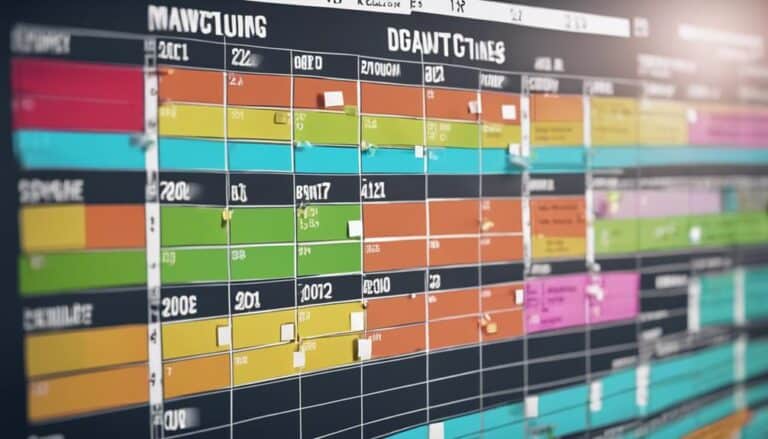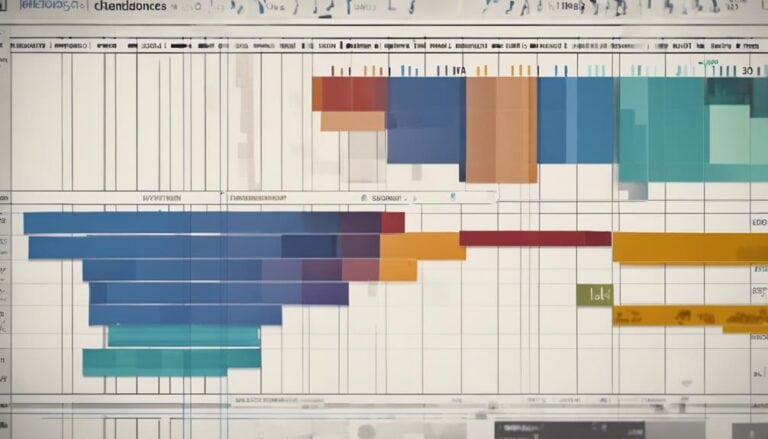In the fast-paced world of project management, the phrase 'time is of the essence' couldn't be more relevant than when working with small teams. Understanding how to effectively plan projects with limited resources and manpower is crucial for success.
But what specific strategies can you implement to ensure your small team maximizes efficiency and delivers quality results within set deadlines? Let's explore some key tactics that can make a significant difference in your project planning approach.
Key Takeaways
- Define clear project scope and goals to prevent scope creep and align team efforts.
- Build a strong project team by identifying skills, defining roles, and fostering communication.
- Create a solid project plan through task prioritization, resource allocation, and risk assessment.
- Monitor project progress with tracking milestones, regular updates, and using project management tools.
Defining Project Scope and Goals
To kickstart your project planning process effectively, begin by clearly defining the project scope and outlining specific goals that will guide your team towards successful outcomes. Defining the project scope involves outlining the boundaries and objectives of the project clearly. This step ensures that everyone involved understands what's included within the project and what's not, preventing scope creep.
Setting specific goals is equally crucial as it helps in focusing team efforts towards achieving desired outcomes. Clear project scope and goals are essential to ensure project alignment, where every team member is working towards the same objectives. A well-defined project scope and goals serve as a roadmap for successful project completion.
Building a Strong Project Team
Building a strong project team starts with identifying the necessary skills and expertise required for the project. Each team member should bring specific competencies that align with the project's goals. Defining clear roles and responsibilities within the team enhances efficiency and ensures accountability. When team members understand their tasks and expectations, it leads to smoother workflow and better outcomes. Effective communication among team members is crucial for fostering collaboration and coordination. By sharing information openly and consistently, the team can work together seamlessly towards project success.
Creating a supportive team environment is essential for encouraging innovation and problem-solving. When team members feel valued and supported, they're more likely to think creatively and find solutions to challenges. Recognizing and appreciating individual contributions helps boost team morale and productivity. This positive reinforcement contributes to a higher level of commitment and dedication from all team members. By promoting a culture of collaboration, innovation, and recognition, the team can work cohesively towards achieving its objectives with efficiency and accountability.
Creating a Solid Project Plan
Crafting a solid project plan involves meticulous outlining of goals, tasks, timelines, and responsibilities, fostering clarity and direction for your small team's successful execution.
To create a robust project plan for your small team, consider the following key elements:
- Task Prioritization: Clearly define and prioritize tasks to ensure that essential activities are completed on time, keeping the project on track.
- Resource Allocation: Allocate resources effectively, considering the skills and availability of team members to maximize efficiency and productivity.
- Risk Assessment: Identify potential risks and develop strategies to mitigate them, safeguarding your project against unforeseen challenges during execution.
Effective project planning for small teams hinges on regular communication among team members to foster collaboration and ensure everyone is aligned. Remember, adaptation and adjustment are crucial; be prepared to modify your project plan as needed to address changing circumstances and optimize project execution.
Monitoring Project Progress
Monitoring project progress involves consistently tracking key milestones and deliverables to ensure timely completion and address any issues promptly. By utilizing project management tools such as Gantt charts and Kanban boards, you can effectively visualize the progress of your project. These tools provide a clear overview of tasks, deadlines, and team responsibilities, aiding in tracking milestones and making necessary adjustments to the timeline or resource allocation. Regular progress updates and check-ins help identify any potential delays or bottlenecks early on, allowing for proactive measures to keep the project on track. This monitoring process not only ensures timely delivery but also fosters a sense of accountability and transparency within the team. To emphasize the importance of monitoring progress, the table below highlights the key benefits it brings to your project:
| Benefits of Monitoring Project Progress |
|---|
| Ensures Timely Completion |
| Facilitates Adjustments to Timeline |
| Enhances Accountability and Transparency |
Mitigating Project Risks
When managing project risks, your focus should be on identifying potential threats and developing contingency plans to address them effectively.
By proactively planning for unexpected events, you can minimize disruptions and keep your project on track.
Implementing risk mitigation measures increases your project's resilience and enhances its chances of successful completion.
Risk Identification Strategies
To effectively mitigate project risks, start by identifying potential risks through comprehensive analysis and input from stakeholders. Here are key strategies for risk identification:
- Thorough Analysis: Conduct in-depth evaluations to uncover all possible risks.
- Stakeholder Input: Collaborate with team members and relevant parties to gain diverse perspectives.
- Risk Register: Document and prioritize risks in a structured manner to facilitate effective mitigation planning.
Contingency Planning Measures
To further safeguard your project's success and maintain a proactive stance against potential risks, implementing robust contingency planning measures is essential. Contingency plans are proactive strategies that focus on minimizing disruptions by having backup plans ready for unforeseen events. These response strategies help in maintaining project timelines and objectives, ensuring that your project stays on track even in challenging situations. By developing effective contingency planning measures, you can enhance your project's resilience and increase the likelihood of successful outcomes. Mitigating risks through foresight and preparedness is key to navigating uncertainties and ensuring the overall success of your project.
| Contingency Plans | Proactive Strategies | Minimizing Disruptions |
|---|---|---|
| Backup Plans | Unforeseen Events | Response Strategies |
| Timelines & Objectives | Project Resilience | Successful Outcomes |
Efficient Project Closure
Efficiently wrapping up a project involves completing all deliverables and documenting valuable lessons learned for future endeavors. To achieve an efficient project closure, consider the following:
- Project Review: Conduct a comprehensive project review to evaluate the success of the project against its initial goals and objectives. This assessment helps in understanding what worked well and what could be improved upon for future projects.
- Handover Outcomes: Ensure a proper handover of project outcomes to stakeholders and relevant parties. Clear communication and documentation of outcomes are essential for the seamless transition of responsibilities.
- Reduce Scope Creep: Timely closure of a project helps in reducing the risk of scope creep. By defining and sticking to the project scope, you can ensure that resources are allocated efficiently and project goals are achieved within the set parameters.
Top Tools for Small Teams
When considering tools for small teams, it's essential to focus on collaboration tools and task management apps.
These types of applications can enhance communication, streamline workflows, and boost productivity within your team.
Look for platforms that cater to your specific project needs and promote efficient project planning and execution.
Collaboration Tools
With an array of powerful features, collaboration tools like Slack and Microsoft Teams revolutionize communication and teamwork for small teams. These tools offer:
- Real-time messaging capabilities for instant communication.
- Efficient file sharing to streamline collaboration on projects.
- Project management capabilities to keep tasks organized and on track.
Slack boasts over 10 million daily active users, making it a popular choice for team communication, while Microsoft Teams seamlessly integrates with other Microsoft Office tools, providing a comprehensive collaboration platform.
These tools are essential for small teams looking to enhance communication, stay productive, and effectively collaborate, especially in remote work environments.
Task Management Apps
Task management apps play a crucial role in helping small teams organize and prioritize their tasks effectively. By centralizing task management, these apps like Trello and Asana aid in meeting project deadlines and improving communication among team members. Trello's visual boards and card systems make task tracking and assignment simple, while Asana's customizable project templates and task lists streamline collaboration. Small teams benefit greatly from these tools as they enhance productivity and assist in meeting project milestones efficiently. Check out the table below for a quick comparison:
| Task Management App | Key Features |
|---|---|
| Trello | Visual boards, card systems for task tracking |
| Asana | Customizable project templates, task lists for collaboration |
Enhancing Project Management Skills
To enhance project management skills for small teams, focus on fostering clear communication and efficient task allocation within your team. Here are three key strategies to help you improve your project management skills:
- Regular Collaboration: Encourage open communication channels within your small team to ensure that everyone is on the same page regarding project goals, timelines, and responsibilities. Regular check-ins and status updates can help identify any potential issues early on and allow for quick adjustments.
- Utilize Tools and Technologies: Make use of project management tools and technologies to streamline your planning and tracking processes. Tools such as Trello, Asana, or Slack can help you assign tasks, set deadlines, and monitor progress effectively. Leveraging these resources can enhance efficiency and organization within your team.
- Efficient Planning and Tracking: Develop a detailed project plan outlining key milestones, deliverables, and timelines. Regularly track progress against these benchmarks to ensure that your team is on target to meet project deadlines. Adjust your plan as needed to adapt to any changes or challenges that may arise during the project lifecycle.
Frequently Asked Questions
How Do You Handle Multiple Projects With a Small Team?
When handling multiple projects with a small team, time management is crucial. Prioritize tasks, delegate responsibilities according to expertise, use effective communication, allocate resources wisely, track progress, consider agile methodology, assess risks, engage stakeholders, and promote team collaboration for success.
What Are the Key Ways to Manage Small Projects?
When managing small projects, prioritize task delegation, time tracking, resource allocation, communication channels, progress monitoring, risk assessment, budget planning, stakeholder involvement, agile approach, and quality control. These strategies foster efficiency and success for your team.
How Project Management Can Improve Small Enterprises Planning?
Improving small enterprises' planning involves effective resource allocation, time management, communication strategies, risk assessment, task delegation, stakeholder engagement, budget tracking, quality control, agile methodology, and team collaboration. These aspects enhance project outcomes and overall business success.
How Do You Plan a Small Project?
When planning a small project, you begin by setting clear goals, delegating tasks effectively, managing time wisely, allocating resources efficiently, communicating openly, assessing risks, engaging stakeholders, using agile methods, tracking progress, planning budgets, and ensuring quality control.
Conclusion
You've learned key strategies for effective project planning with small teams.
Did you know that 97% of small businesses believe project management is critical to their success?
By defining goals, building a strong team, creating a solid plan, monitoring progress, mitigating risks, and efficiently closing projects, you can achieve successful outcomes.
Utilize top tools, enhance your project management skills, and celebrate milestones along the way to boost productivity and meet deadlines with ease.





